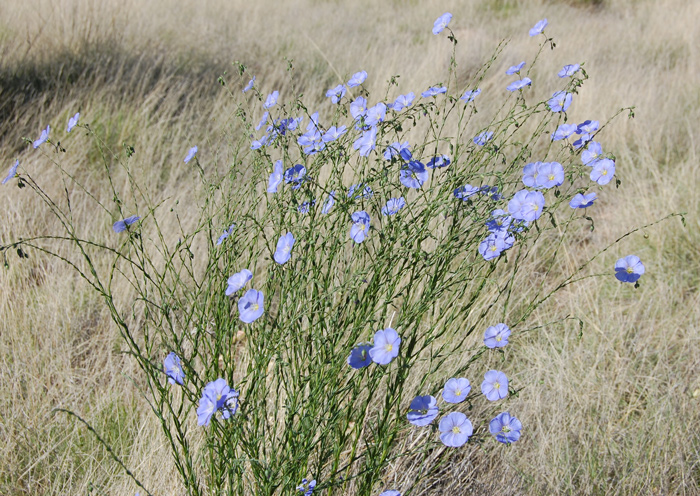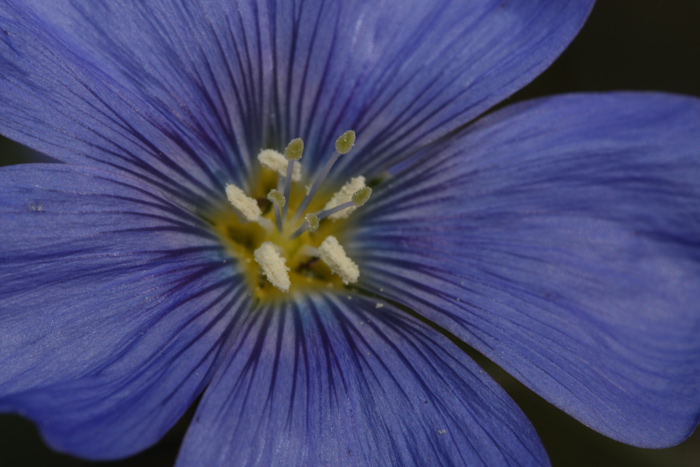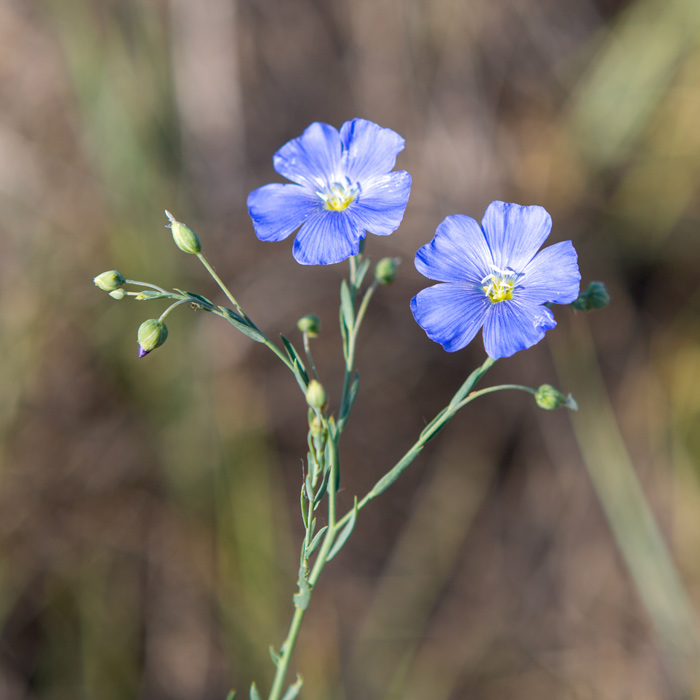Lewis's Blue Flax
- Linum lewisii Pursh
- Flax family (Linaceae)
Narration:
General Information
- Plants: Perennial herbs, 8 to 32 inches tall, with numerous, closely spaced stems. Alternate, narrow leaves with parallel margins, less than 1 1/4 inches long.
- Flowers: Arranged in racemes or panicles with few branches; five sepals, five bright-blue petals, five stamens, and five styles per flower.
- Fruits: Capsules with ten cells.
- Flowering Season: May to August.
- Habitat/Range: Sandy or rocky soil of prairies, open mountain-slopes, and alpine ridges throughout western North America.1
Blackfeet Ethnobotany*
by Darnell and Smokey Rides At The Door
The Blackfeet name for blue flex is Aa Pinii Sinii. It translates to 'morning opens, closes in evening' after the nature of the flowers opening and closing each night, and symbolizes giving good day greetings. The strong, flexible stems of this flower are used to braid ropes, lines, and used to tie or wrap items that needed to be held together.2
From the Journals
by H. Wayne Phillips
Two specimens of Lewis’s blue flax were collected on the Lewis and Clark Expedition and still exist in the Academy of Natural Sciences in Philadelphia. The label of one places its collection on July 9, 1806, along the present-day Sun River above Simms, Montana.3
Lewis, however, described blue flax in the journals before collecting this particular specimen. On July 18, 1805, near Holter Lake, Montana, Lewis describes Lewis’s blue flax:
I have observed for several days a species of flax growing in the river bottoms the leaf stem and pericarp of which resembles the common flax cultivated in the U’ States . . . . the seed are not yet ripe but I hope to have an opportunity of collecting some of them after they are so if it should on experiment prove to yeald good flax and at the same time admit of being cut without injuring the perennial root it will be a most valuable plant.4
Lewis flax quickly became a popular plant upon being sent to Philadelphia. Bernard McMahon, one of the stewards of Lewis' plant collections, began offering the plant as early as 1815, though never rose to the level of prominence in American gardens on the East Coast compared to the European counterpart plants.5
Additional Information: Both the common name and the scientific species name for this plant is named after Meriwether Lewis. The plant is used by some wildlife and livestock as a decent forage food. The seeds have often been used medicinally by some traditional cultures, and though raw they do contain cyanide, when cooked can be enjoyed as a tasty treat or used to extract oil. The stems are fiberous and have been used to make cloth or as weaving material.6
*While traditional medicine is still practiced in many cultures including the Blackfeet culture and has many uses, please do not consume any plant material without consultation of a health professional.

Bergianska trädgården. © 2012 by C. T. Johansson. Permission to use granted under the Creative Commons Attribution-ShareAlike 3.0 Unported license.

© 2007 by Wikimedia Commons user Skoch3. Permission to use granted under the Creative Commons Attribution-ShareAlike 3.0 Unported license.

© 2009 by Walter Siegmund. Permission to use granted under the Creative Commons Attribution-ShareAlike 3.0 Unported license

Lewis & Clark Interpretive Center, Great Falls, Montana. © 29 June 2005 by Kristopher K. Townsend. Permission to use granted under the Creative Commons Attribution-Share Alike 4.0 International license.
Notes
- "Linum lewisii Pursh," United States Department of Agriculture Natural Resources Conservation Service Plant Database, plants.usda.gov/home/plantProfile?symbol=LILE3.
- All ethnobotanical information was given or verified by Smokey Rides At The Door and Darnell Rides At The Door. Initial research came from Native American Ethnobotany Database. Please be advised that not all studies included are correct and to consult with Native community members to verify information.
- H. Wayne Phillips, Plants of the Lewis and Clark Expedition (Missoula, Montana: Mountain Press Publishing Company, 2003). H. Wayne Phillips graciously donated his expertise on this subject by writing this narrative.
- The Definitive Journals of Lewis & Clark, Gary Moulton, ed.
- Peggy Cornet, "The Horticultural Potential of Lewis and Clark Plants," We Proceeded On, 36 no. 1 (February 2012).
- "Range Plants of Utah: Lewis Flax," Utah State University, extension.usu.edu/rangeplants/forbsherbaceous/lewis-flax.


